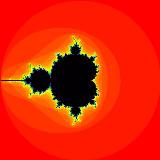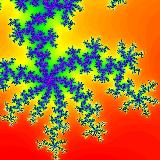
Mandelbrot Set
|
Supercomputer Applications
A Course in Computational Science
Supercomputer Applications is a half-credit semester
course with a suggested AP computer science co-requisite. Students will
explore computational science and high performance computing using
various scientific visualization techniques. Working in a UNIX
environment with full Internet access, students will solve problems using
the C++ programming language, and will display graphics using
OpenGL commands. Students will experiment with parallel computing on
various UNIX systems using PVM. Properly documented programs are
to be submitted in hard copy format along with email versions and
written discussion where appropriate. Students are also expected to
present examples of their projects in a web page format.
|
Goals:
The student in Supercomputer Applications will
- write properly documented, well structured programs
emphasizing computer graphics using OpenGL in the
language C or C++.
- learn fundamentals of the UNIX operating system and
use of Internet resources as applied to computational
science.
- investigate algorithm design considerations related to
high performance computing while running programs
using PVM (Parallel Virtual Machine).
- study computationally intensive problem solving
techniques while investigating dynamical systems,
chaos, fractals, and ray tracing.
- develop projects using scientific visualization techniques.
|

Mandelbrot Detail
|
General Description:
Supercomputer Applications is a half-credit semester
course with a suggested AP computer science co-requisite. Students will
explore computational science and high performance computing using
various scientific visualization techniques. Working in a UNIX
environment with full Internet access, students will solve problems using
the C++ programming language, and will display graphics using
OpenGL commands. Students will experiment with parallel computing on
various UNIX systems using PVM. Properly documented programs are
to be submitted in hard copy format along with email versions and
written discussion where appropriate. Students are also expected to
present examples of their projects in a web page format.
Course Content:
A. OpenGL Graphics as Part of the C or C++ Languages
- Basic Windowing Operations in a UNIX Environment
2-D Graphing Commands, Plotting in 3-D
Orthographic Projection and Perspective
Wireframe Models and Surfaces
Mouse and Keyboard Routines
Transformation Matrices: PushMatrix, PopMatrix, Rotation, Translation, and Scaling
Animation and Double Buffering
GLUT: Polygon Models, Objects, Surface Normals, and Lighting
B. Investigating Dynamical Systems, Fractals, and Chaos
- Verhulst Dynamics, Bifurcation and Chaos
Fractals: Mandelbrot Set, Julia Sets, Orbits of Points
L-Systems
Twist & Flip Paradigm
Newton's Method in the Complex Plane
C. Supercomputer Access in a UNIX Environment
- Basic UNIX Skills:
- Commands, On-line Help (man pages), File Access, Editing,
Compiling, UNIX Scripts
Web Page Skills:
-
Basic HTML, Simple CGI and Perl Scripts
Graphics Files:
-
RGB Colors, File Formats (Targa, Gif, Jpeg, Postscript),
Graphics Manipulation using xv, the Gimp
Network and Internet Skills:
- Ethernet, Telnet, FTP, Search Engines
Programming Considerations:
- Algorithm Design, Vectorization,
Parallel Computing using PVM
D. Introduction to Ray Tracing
-
Using POV-Ray (Persistence of Vision Ray Tracer)
E. Introduction to Computational Science and Computer Simulation Techniques
-
Getting Started with
Supercomputing, Scientific Visualization Strategies
-
Trajectory Simulation:
- Prototype Development, Model
Validation, Graphics Visualization, Supercomputer Assistance
Gypsy Moth Simulation:
- Biological Model, Finite State Automaton Techniques
Random Walk:
- Discrete Limited Aggregation Model of Crystal Growth
Primary Texts:
-
Chaos, Fractals, and Dynamics: Computer Experiments in
Mathematics,
Robert L. Devaney, Addison-Wesley, 1990.
Object-Oriented Programming in C++, Second Edition, Robert
Lafore,
Waite Group Press, 1995.
OpenGL Programming Guide, Second Edition, Mason Woo, Jackie Neider, and Tom Davis, Addison-Wesley Developers Press, 1997.
Resource Books:
-
Chaos and Fractals: New Frontiers of Science, Heinz-Otto Peitgen, Harmut Jurgens, and Dietmar Saupe, Springer-Verlag, 1992.
Chaos: Making a New Science, James Gleick, Viking Press, 1987.
Instructors:
Donald W. Hyatt
dhyatt@tjhsst.edu
Phyllis T. Rittman
prittman@tjhsst.edu
|

